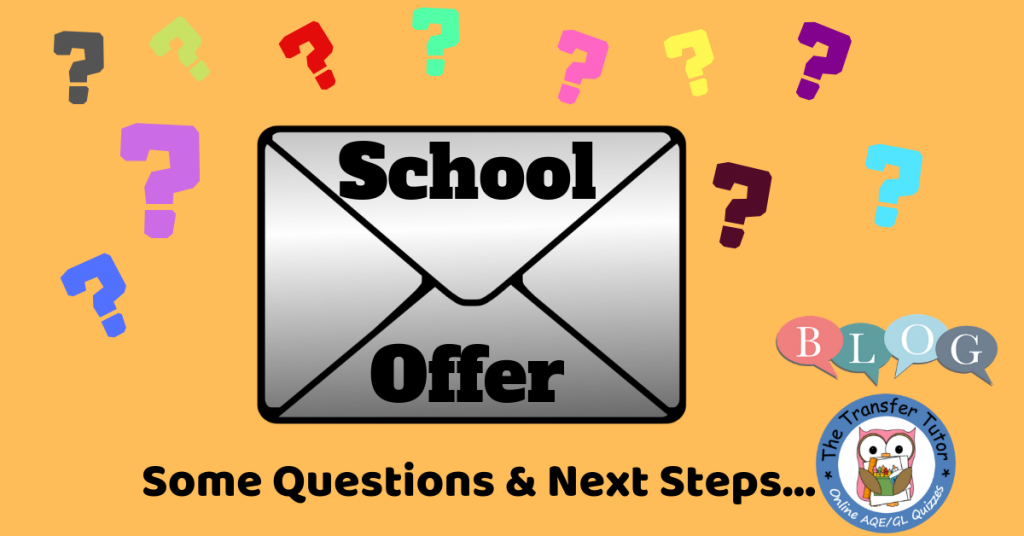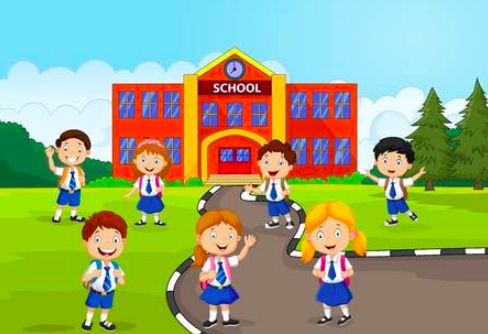
Letters will be received on the 1st June 2019 confirming the post-primary school where your child has been offered a place – or a letter from the Education Authority (EA) telling you that your child has been unplaced. So here’s what you need to do in the different scenarios and this blog covers answers to some other key questions you may also have.
Please note – on the 1st June, the school-offer letter comes from the grammar or high school, so it will usually have clear branding on the front, or you can peak through the address window and find out the sender. However, if your child is unplaced, the EA letter will be more plain and may or may not have branding, so just be careful in case you’re letting the child open their own letter – as you don’t want them opening a letter that isn’t offering them a place.
Your Child Secured A Place In Their First Preference School And All Is Good Under The Hood!

Well done! Time to celebrate success.
The only thing you’ll need to do is fill in the acceptance forms and return these to the post-primary school which your child will be going to in September 2019.
Your Child Secured A Place In Their First Preference School – But You’ve Changed Your Mind

Change can happen for a number of reasons e.g. moving house, so securing your first place school may not actually be what you want anymore. The challenge you’ll have at this stage is that the other schools you prefer, may now be full. However, there is always some movement, so you’ll have to act quickly and get yourself on the waiting list for the school(s) you would like to apply to.
For further information, see below – How Waiting Lists Work.
Your Child Was Offered A School Place But You’re Not Happy And Still Want To Try For Another School

Okay, firstly try not to be too disappointed but also know the journey doesn’t have to end here. You may feel that you’ve lost out in your other preference school(s) but don’t lose hope completely as there’s always a lot of movement in admissions, even after school letters go out.
At the same time, try to be realistic with your expectations. We will inevitably be discussing lowest scores on the free, Facebook AQE & GL Support Group so this will offer you a general indication of the level accepted for specific grammar schools – but this is only an indication as a school may run pools or have siblings at the school which put them higher in their admission criteria.
Although it may be tough mentally and your school offer is not what you or the child may want, I would advise to try to accept this school offer in your mind and heart, but just hold a little bit of hope of some change (either for 2019 or even for 2020).
At this stage, you may want to go onto the waiting list for other schools you would like to consider and the for further information on this process can be found below – How Waiting Lists Work.
Your Child Received A Letter From The Education Authority Saying The Child Is Unplaced (No Offer Of Any School)

The Unplaced Letter
In case you missed the warning at the top of this blog, you can identify this ‘unplaced letter’ as it will not have the normal grammar or high school branding on the front, so just be careful if you receive a letter where you can’t identify the sender, as this is not the type of letter you would want your child to open.
What Unplaced Means
‘Unplaced’ basically means that, from the school choices you indicated in the post-primary transfer form, when the schools applied their admissions criteria, your child was not ranked as high as the other children who were offered a place. This may be because of the AQE/GL score, or the other child had a sibling at the school, they were not in a feeder primary school, or some other reason. Either way, don’t worry about the reasons why too much at this stage, but you’ll need to move quickly to maximise your options now.
It’s worth noting that there are enough places in all post-primary schools for every child in NI’s primary schools but inevitably some schools will be more popular than others.
Letter From Education Authority (EA)
The letter you receive from the EA will have advice for you and will also include a link to their website which will show you the post-primary schools that still have places. Click here and have a look at which schools still have spaces at this time.
Do Your Research
You may be familiar with the schools (with available places) already, but nothing is going to happen until the Monday 3rd June, so take the time on Saturday and Sunday to do your research on the available schools that you may not have previously considered.
Check their website, their social media pages, ask friends and family or even use the AQE/GL Support Group if you need some help (although I have a policy of positivity within the group, so you’re not going to hear any schools being openly criticised as that does not help anyone make value judgements).
Monday Morning – Contact EA.
Then on Monday morning at 9am you’ll be in a great position to discuss options with the Education Authority (phone EA Helpline on 02895 985595, (option 1 as a parent, then option 3 for post-primary) and put your child’s name down for one of the available places. Do not delay in making this call as available places will fill up quickly.
Once you contact the EA they will manage your post-primary transfer form and send it to the available school to secure your place.
You Didn’t Receive Any Letter

In the case that you’ve still not received a letter by 12 noon on the 1st June 2019, you can phone the EA Helpline on 02895 985595, (option 1 as a parent, then option 3 for post-primary) and after clearing some security questions, they will confirm your child’s post-primary offer over the phone. I imagine this will also work well if you’re not at home on this day.
Please note, the EA Helpline will operate from 12 noon – 5pm and the staff will not be able to deal with any of the queries above – they will simply be looking up your child’s name and confirm school place.
Will The Child’s Primary School Be Informed Of The School Offer?

Yes, the principal of your child’s primary school will receive a Placement List and this will include a table of all their P7 children and the school they have been offered.
However, it’s important to note that they will only receive the placement list on the same day as you receive your post so this does not offer you a shortcut to finding out the school allocation any earlier.
In addition, although the teacher will know, they will not be sharing this information with anyone else (either within or outside the classroom) – this is very much the child’s news to share with their classmates if they want to. They just need to know for the child’s mental wellbeing and this means they can offer support to the child if needed, which is a good thing.
How Waiting Lists Work

I wish I could say that there was one super-computer in a central location, managing all the people on the post-primary waiting lists, but I can’t.
The reality is that at this stage, once all the formality of the admission criteria and the EA process has been completed, the post-primary schools are free to manage their own waiting lists and the way they do this will vary considerably.
Different Ways Schools Can Manage Waiting Lists
Here are some ways that post-primary schools can manage their waiting lists:
- They can run a waiting list on a first-come, first-served basis, so any free spaces that comes up are given to the people who made a request to be put on the waiting list first.
- They can collect all names for a waiting list and at a point in time, they apply their own admission criteria and offer the place to the child at the highest point.
- They can hold the names of people who had previously applied to the school but were not successful and then in admission criteria order (usually), contact the parents and offer a place if it comes available.
Getting Your Child’s Name Onto The Waiting List
You can put your child’s name onto one or several waiting lists if you need to, as they will be managed by the individual schools.
Firstly, you need to contact the post-primary school and ask what you need to do to put your child onto a waiting list.
It might be that you have to fill in a simple application form, or it might be that the secretary will simply add your child’s name to their list there and then (along with their test score, if relevant) – either way, rest assured that the process is not going to be onerous.
Names On The Waiting List
Once your child’s name is on that waiting list, some schools may then give you an indication as to their position e.g. your child is fifth on the waiting list, and this basically means that five other people would have to give up their space, due to changes in their own circumstances, for you to be offered a place.
In addition, as people are added to the list, depending on how the post-primary manage their list, names may trump others on the list, so this fifth can move up or down.
Inform Schools If You No Longer Want To Be On Their List
It’s only polite that if you find your child has settled on a school choice and you no longer desire to be on a waiting list, that you inform any schools where their name is still on the list and you inform them that you’re no longer interested.
I’m sure the post-primary school would really appreciate your support on this at this busy time.

Can I Appeal The Decision?
You can’t appeal on the grounds that you simply don’t like the result but there is an appeals process which you can use if you don’t feel a post-primary school has correctly applied its admissions criteria in deciding to refuse the child admission to the school.
Independent tribunals will be established by the Education Authority to consider appeals and these tribunals will review the evidence and decide on whether or not the school did use their admission criteria fairly when considering your child’s application.
For a detailed overview of this process, please read the PDF below.
Will I Now Get A Free Bus / Rail Pass?

Although you may not be very happy with your offer (if you didn’t get first choice), free transport assistance could be a welcome bonus in the process.
Rules
In short, the EA will provide you with transport assistance (bus or train pass) if you don’t have a similar school type within three miles of your home (this becomes two miles for primary school age).
The different types (referred to above) are detailed as:
- Voluntary Controlled Grammar – funded by EA through Board of Governors. School Boards consists of church representatives (mainly Protestant) along with parents, teachers and EA. e.g. Methody, Victoria etc.
- Catholic Maintained Grammar – managed Board of Governors. School Boards consists of church representatives (mainly Catholic) along with parents, teachers and EA e.g. St Malachy’s and Rathmore
- Voluntary Controlled Secondary – mainly protestant high schools
- Catholic Maintained Secondary – mainly catholic high schools
- Integrated (having formal integrated status)
- Irish-medium schools
If you have a similar type (see breakdown above) of school within three miles of your home, then you will not normally be offered a bus pass.
However, if you applied to all of this type of schools within three miles radius of your home and you were unsuccessful at gaining a place, then you would be offered transport assistance.
Eligibility Tracker (Transport)
The easiest way to check if you have a chance at a free bus or rail pass is to use the Transport Eligibility Tracker (or click on image above). Steps:
- Click on the Transport Eligibility Tracker link.
- Select Year 8, Post Primary and the School your child will be going to.
- Put in your post-code and search for your address
- Agree to the terms and conditions and Submit.
Through the instance response which you will show on the screen, you will see the schools that are within the three mile radius for the type of school that you put down as a preference – so, if you did apply to these and was not offered a place, there’s a very high chance you would then get a free travel pass.
If you have any further enquires about transport, you can phone the Transport Helpline on 0300 200 7824.
More about The Transfer Tutor (Multi-Award Winning Online Quizzes)

If your child is in P6, I would strongly recommend The Transfer Tutor’s online quizzes to provide fun and interactive quizzes aligned directly to the AQE and GL specifications. All quizzes are broken down into manageable topics and can be done on any mobile or tablet device, so it’s a great way for kids to learn and prepare for the test.
If your child is in P6 and you want the licence that will last you until December 2019, simply click on the picture below to buy the Penguin Licence at only £45 which will give you access until the test is over.
All of these are a one-off payment until they expire.

PENGUIN LICENCE – Only £45
(Expires December 2019)
Error! The button ID (1929) you specified in the shortcode does not exist. You may have deleted this payment button. Go to the Manage Payment Buttons interface then copy and paste the correct button ID in the shortcode.
CAT LICENCE – Only £60
(Expires December 2020)
Error! The button ID (2011) you specified in the shortcode does not exist. You may have deleted this payment button. Go to the Manage Payment Buttons interface then copy and paste the correct button ID in the shortcode.
ELEPHANT LICENCE – Only £75
(Expires December 2021)
Error! The button ID (2861) you specified in the shortcode does not exist. You may have deleted this payment button. Go to the Manage Payment Buttons interface then copy and paste the correct button ID in the shortcode.
There is such a buzz at the moment and this is because The Transfer Tutor :
- Has a complete focus on the AQE & GL specification.
- Is mobile friendly working on smartphones and tablets which most children have access to.
- In many questions, there will be a ‘hint’ option that offers the child details on the ‘rule’ or aids them to complete it correctly which helps their future application of the same type of question.
- Has a function built in that the parents will be emailed with the child’s score when they have completed a test, so parents can track progress and also know the child is not off playing Minecraft or Candy Crush when they should be revising.
- Question areas broken down into specific categories which allows the parent and child to identify areas of weakness and to focus on these for improvement.
- Although tests will have more than 20 questions ‘behind the scenes’, the child is only faced with a random 20 questions each time so they can try the same test many times and will be getting different related challenges.
- Not just practice questions, but if the child gets it wrong, the system will provide information on the rule or reason as to why this is happened, so they can build on their fundamental learning for the next time.
- Leader board with the most recent 10 attempts listed (from all people) and this offers a level of competition that makes the child strive to be better.
- Child friendly with the use of colours and pictures which encourages the child to want to log on and try a new quiz every day.
To give you a feel for the quizzes, you can start a free one by clicking on the button below.

The quizzes have been a great success with parents and kids and received many, over six hundred 5* Google & Facebook Reviews in the last year, so definitely worth a look and read how so many people have loved using the online quizzes to learn.

